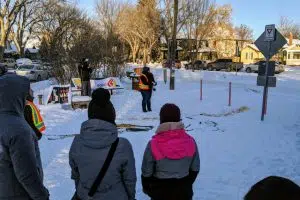The extreme cold didn’t stop a crowd of over 50 people from marching for women’s rights in Saskatoon on Saturday.
Marching for equal rights and putting an end to the status quo isn’t easy — especially on a cold January day in Saskatchewan — but coming together and making a stand is never easy either, according to organiser Kate Lardner.
That’s why Saturday’s crowd gave her confidence for the movement to grow and change.
“I think it’s taken on a more broad purpose,” she said. “Women of race, women in the LGBTQ community — there’s so many different issues. Each year kind of has a different purpose as to why we are marching.”

Kate Lardner speaks to the crowd gathered ahead of the Saskatoon Women’s March 2020. (Keenan Sorokan/650 CKOM)
Women’s marches across the world began after a worldwide protest march in Washington D.C., on January 21, 2017, towards then newly inaugurated U.S. President Donald Trump.
In Saskatoon, the march on Saturday featured speakers, a vigil for missing and murdered Indigenous women and girls, in addition to the march itself.
Carrie Klassen sees a lot more potential as the marches expand causes and goals.
“What we’d like to see more of is the intersectionality of feminism. I think this movement in the first few waves of feminism really focused on the white, middle class. What we’d like to do is push that into a bigger scope,” she said.
Klassen mentioned that scope could include examining women and compounding issues, such as race, gender, sexual orientation that intensify discrimination.
Many participants in the march felt the movement is just scratching the surface of the issue as it enters a new decade.
Klassen mentioned various types of inequality show discrimination, and that’s why these marches will only get bigger.
“Race inequality is gender inequality is economic inequality, and that all of those compound and intersect within each other,” she said. “It’s important that our march symbolise that.”











